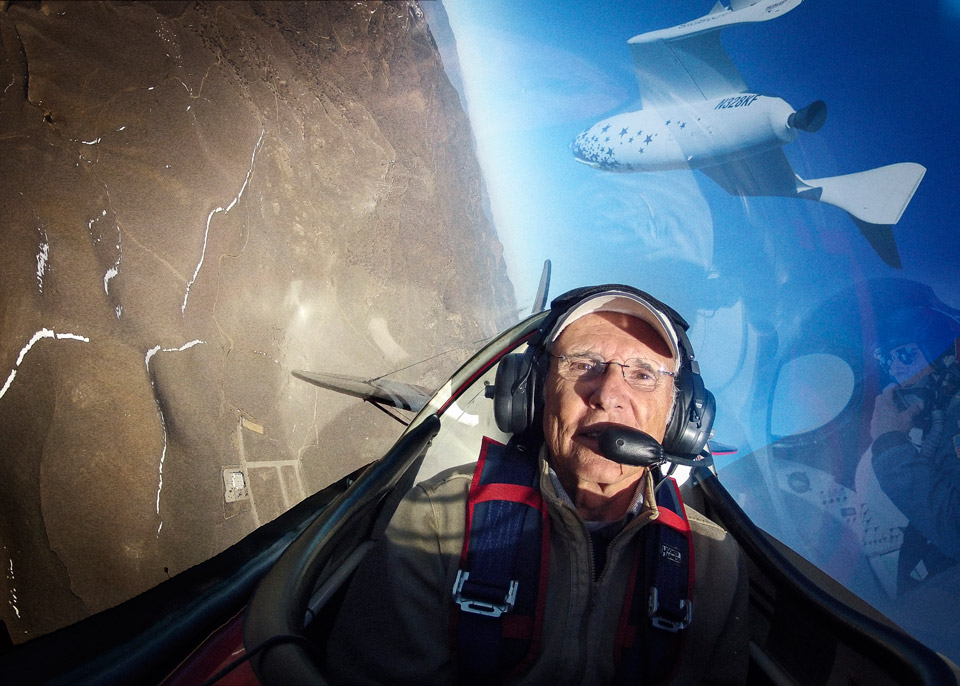Photo illustration by Mike Fizer
Alone in the sleek, composite shell of an experimental spacecraft he helped build, suspended beneath the broad wings of the White Knight carrier airplane, test pilot Mike Melvill is glad to finally get busy.
The two aircraft have been ascending together for nearly an hour, and at 47,000 feet over the California desert, the White Knight’s two General Electric J85 turbojets have lifted Melvill and SpaceShipOne as high as they can.
Melvill, then 63, goes through his final checklist items and removes the safety wire from the rocket motor arming switches as he prepares to fly into space. He’s practiced this sequence of events thousands of times, but on June 21, 2004, it’s for real.
At 7:50 a.m., SpaceShipOne is released from the pylon that’s held it in place during its long ride to altitude, and as it falls, Melvill arms and then fires the rocket motor, which contains two fuels: 600 pounds of rubber and 3,020 pounds of liquefied nitrous oxide. It takes less than two seconds for the rocket motor to fire—but to Melvill, the wait seems far longer.
Then a violent jolt of acceleration shoots the craft forward and lets the pilot know the motor is blasting away at full power. The 3.5 Gs of straight-line, “eyeballs-in” acceleration throw Melvill against his seat back with roughly the same force as a top-fuel dragster at the starting line, and he pulls firmly on the control stick to point the nose of his craft straight up to the heavens. In addition to being pushed back, he’s now being yanked down in his seat by 4 Gs.
The disorienting sensations require complete focus and absolute trust in the experimental avionics that show the aircraft’s attitude, and Melvill handles the craft with the firmness and precision honed during three decades of flight tests on a wide range of unique aircraft ranging from a long-winged, glider-like drone to jets.
But just a few seconds into the fast-ascending flight, SpaceShipOne encounters a powerful wind shear in the upper levels of the atmosphere and the aircraft suddenly rolls 90 degrees to the right. Melvill counters with left rudder and left stick, but at the nearly supersonic speed the aircraft is now traveling, the controls are almost too stiff for the wiry former machinist to move. He uses a thumb switch that trims the aircraft to roll left and holds it, but the correction becomes too great. SpaceShipOne is rolling left and the trim won’t reverse back to the right, and the spacecraft’s speed and trajectory aren’t exactly as planned.
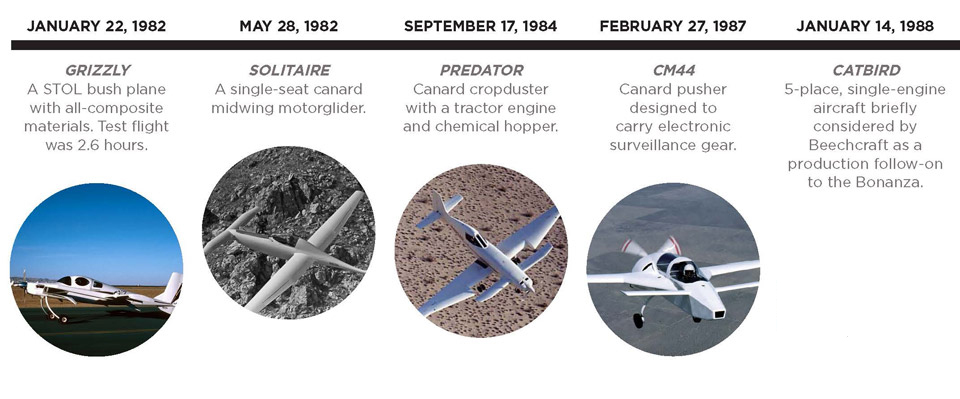
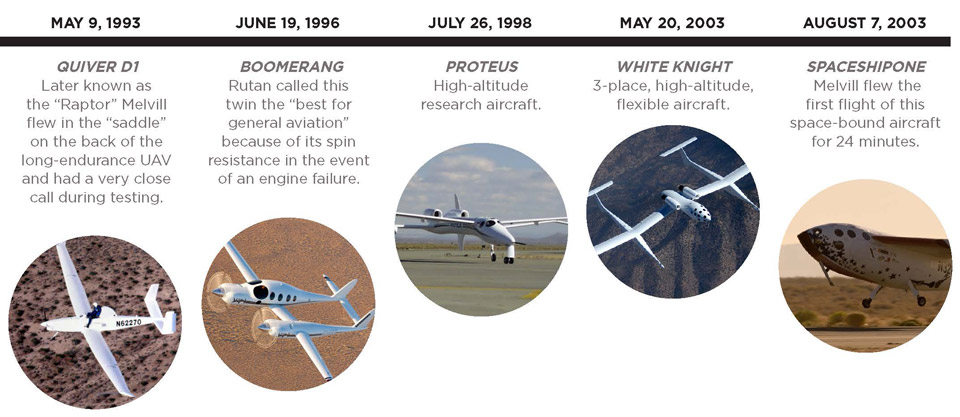
Then there’s a loud bang and a shudder runs through the airframe, and Melvill can’t identify the sound. He considers cutting off the rocket motor, but he allows it to keep firing for the full 76 seconds until all the propellant is gone. At 180,000 feet, he’s traveling Mach 2.9 and 2,150 miles per hour—and rising almost vertically.
SpaceShipOne reaches the top of its arc at 328,491 feet, or more than 100 kilometers above Earth. Melvill is weightless for three and a half minutes, and surveys the world through the many round windows in the aircraft’s nose. He playfully opens a bag of peanut M&Ms and lets the colorful candy float throughout the cockpit—an impromptu gag for the onboard video camera.
While he tries to project an air of calm and confidence, the most harrowing part of the flight—reentry into the atmosphere—is still to come. And although Melvill is certain the plan of his friend, designer Burt Rutan, to bend SpaceShipOne into a draggy “shuttlecock” for a relatively low-speed descent will work, it’s never been attempted from anywhere close to this altitude. With the blackness of space overhead, the brilliant blue line of the atmosphere on the horizon, and an entire vista of Southern California from the coast to the desert below, SpaceShipOne begins its long and irreversible fall.
Melvill pulls a handle that tilts the craft’s twin tail booms up 75 degrees and prepares for what’s sure to be a wild ride.
The unanticipated roll during its ascent into space, and Melvill’s hurried and abrupt corrections, has put SpaceShipOne about 22 miles away from its planned reentry point. Melvill is sure he can glide safely back to the Mojave Airport—but first he has to make it through the coming trial of reentry.
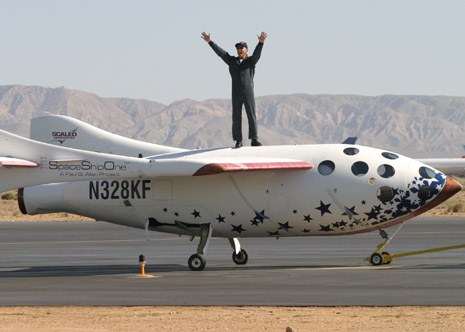 Unlikeliest astronaut. Mike Melvill doesn’t fit the typical military-trained, academically overachieving astronaut profile. The South Africa native failed a math course and never finished high school. He raced motorcycles and became a machinist at 17. He married his childhood sweetheart, Sally, and they emigrated to the United States in the late 1960s. He became a U.S. citizen in 1972, and his motivation to fly was a dislike of airline travel—not a dream of exploration.
Unlikeliest astronaut. Mike Melvill doesn’t fit the typical military-trained, academically overachieving astronaut profile. The South Africa native failed a math course and never finished high school. He raced motorcycles and became a machinist at 17. He married his childhood sweetheart, Sally, and they emigrated to the United States in the late 1960s. He became a U.S. citizen in 1972, and his motivation to fly was a dislike of airline travel—not a dream of exploration.
Melvill lived and worked in Muncie, Indiana, and his innate ability to diagnose and fix broken machinery had him traveling throughout the country to repair specialized industrial box-cutting machines. During the tedious waits in airport terminals, he came to believe that he could do his job more efficiently if he could fly his own airplane to job sites.
“Once I had my private, commercial, and instrument ratings, I began to look forward to people breaking things because it meant I got to fly,” he said. “I thoroughly enjoyed all aspects of flying and wanted to do it as much as possible.”
Melvill traveled to Oshkosh, Wisconsin, for the EAA convention in 1974 and bought a set of plans for an airplane called a VariViggen from designer Rutan, who was selling them from the backseat of his own VariViggen on the flight line. Melvill knew how to build things from blueprints, and he became the first customer to complete a VariViggen. He and Sally flew the odd-looking airplane to the West Coast for a business trip, then on a lark, decided to drop in on Rutan at his home base in Mojave.
Rutan was so impressed with Melvill’s airplane, and with the man who built it, that he offered him a job on the spot. “He said he needed someone to answer builders’ questions because all the customer service he had to provide took away from his real passion, which was designing new airplanes,” Melvill said.
He and Sally talked about the offer during the long series of flights home to Indiana, and with her support, they moved to the dusty, windswept, tumbleweed-strewn high desert town of Mojave. “Sally recognized that this was a rare opportunity, and she saw the possibilities,” Melvill said. “She encouraged me to go ahead and do it.”
Now, Mojave and its bustling spaceport are firmly on the aviation map, and a welcome sign at the highway entrance boasts that it is the “Home of SpaceShipOne.” (There’s the Voyager Cafe at the center of the airfield named in honor of another Rutan design, and Scaled Composites is one of the city’s largest private employers.) Melvill built the first Rutan-designed Long EZ from plans, and he flew the airplane around the world with the designer’s brother, Dick Rutan, in his own Long EZ in 1997.
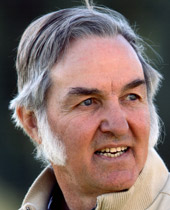
Melvill still owns and flies that two-seat aircraft, which has now logged more than 4,200 flight hours, and he and Sally (also a pilot) have taken it throughout North America during 32 years of flying.
Learning flight test. Melvill did much of the test flying on the Long EZ, as well as all of Rutan’s subsequent designs—which included the Beech Starship, Ares ground-attack aircraft, Grizzly STOL airplane, VisionAire Vantage, Williams V-Jet, and Boomerang piston twin.
“Burt showed me how to fly the maneuvers in a way that allowed him to collect
the data he needed to perfect the aerodynamics and performance of the aircraft,” he said. “The more I did that, the more he trusted me, and the closer we worked together.”
Melvill became general manager of Scaled Composites, and Sally was the head of human resources. Together they invested in the company when Rutan assembled a group that essentially took the firm private, buying it from a series of corporate owners. The Melvills’ investment paid off when defense giant Northrop-Grumman bought the company in 2007.
Melvill, now 72, is an active general aviation pilot and flies an Extra 300L as a chase pilot for SpaceShipTwo flight tests—but he has no intention of flying any more spacecraft. “I made a promise to Sally that I’m done with that,” he said. “We’ve been married 51 years, and the only way you get to do that is by honoring your promises.”
Melvill worked closely with Rutan for three decades (Melvill retired from Scaled Composites in 2007), and the two spoke almost daily. A hands-on pragmatist, Melvill was a sounding board for Rutan, and he often was among the first to learn what the visionary designer was thinking.
“He came into my office almost every morning,” Melvill said. “He would say something like, ‘I think we’ve developed the technical expertise to build a twin, or a jet.’ But I’ll never forget the day he said he thought we had the technical expertise to fly an aircraft into space. It was something I’d never considered. We were doing a credible job with airplanes that flew about 200 miles an hour—but to get to space, we’d have to fly at Mach 3. It seemed too ambitious to seriously contemplate, and I was intimidated.”
Melvill took an active role in each new aircraft design and learned all of them from the ground up. White Knight, the aircraft that was to carry SpaceShipOne aloft, was almost identical inside the cockpit to the smaller spacecraft. “They were literally made from the same mold,” Melvill said. “The only difference inside is that White Knight has throttles and engine instruments. Other than that, they’re exactly the same.”
Rutan had never designed a supersonic aircraft when Scaled Composites began building SpaceShipOne, and many experts doubted the twin tails would survive the resonance that might develop between them at the broad range of airspeeds the craft would travel. “We were confident it would work,” Melvill said. “But there was no shortage of doomsday scenarios for all the bad things that could happen if it didn’t.”
The aircraft was inherently unstable at high speeds, and it required deft pilot handling. On one of its first powered flights, the guidance system failed and Melvill looked out a small side window to stay oriented. On his second space flight, another encounter with high-altitude turbulence caused SpaceShipOne to yaw 15 degrees, pitch up 8 degrees, and started a series of 29 snap rolls that began at 160,000 feet and continued all the way out of the atmosphere. Melvill tried to counter the unwanted rolls but realized, “There’s just not enough air up there to fix that particular problem.”
SpaceShipOne made 17 flights, every one of which redefined what was then known to be possible.
Otherworldly sounds. SpaceShipOne banged into the atmosphere, shaking and rocking as the air beneath it thickened. The air particles were thin and patchy at first, and the spacecraft pitched fore and aft as it encountered them at an ever-increasing speed. Even in its high-drag configuration, SpaceShipOne accelerated to Mach 2.9 in the highest reaches of the atmosphere. As it descended, the forces built steadily to 5 Gs, compressing Melvill into his seat. He had to strain to keep the blood flowing to his head and remain conscious as the powerful forces collided. Outside, wind noise and otherworldly sounds increased with an alarming volume and intensity.
“I was not afraid all the way up,” he said. “But I was a little afraid on the way down. Boy, when you reenter at 2.9 Mach and you start hitting the atmosphere, the noises you hear are somebody talking to you very, very sharply. You know, you begin to think, wow, should I be doing this?”
At an altitude of about 60,000 feet, Melvill reconfigured SpaceShipOne as a glider. The streamlined shape allowed him to take control and maneuver the craft
with a conventional stick and rudder pedals, providing comfort to the veteran pilot.
Even though SpaceShipOne had begun its descent more than 20 miles from the place program engineers had intended, gliding that extra distance was easily done from Melvill’s high perch. But the aircraft was out of trim, and Melvill decided to leave it that way. If the trim system had been compromised during ascent, he didn’t want to exacerbate the situation by changing it now.
The approach and touchdown on Runway 30 at Mojave went according to plan, and much as the previous unpowered flights had ended. For reasons of lightness and simplicity, SpaceShipOne didn’t have brakes. Melvill simply rolled to a stop on the nose skid.
More than 25,000 people had come to Mojave to watch the launch, and millions more tuned in on television. Former NASA astronaut Edwin Eugene “Buzz” Aldrin Jr. was there, as well as then-FAA Administrator Marion Blakey.
“I knew there was a high level of interest in the work we had been doing, but I was surprised and deeply touched that so many people came out to wish us well that day,” he said. “It meant a great deal to everyone on the Scaled team who had put heart and soul into the project.”
Rutan was elated by the success—but also focused on the problems that caused the uncommanded roll, the bang, and the resulting lower altitude (SpaceShipOne had been projected to reach 360,000 feet that day), and missing the reentry point. He vowed not to fly again until the problems had been identified and corrected, and the team considered another test flight before starting the clock on the Ansari X-Prize, a $10 million award for the first reusable civilian spacecraft to fly to space twice within a two-week period.
The Scaled Composites team soon discovered the reasons for the roll (wind shear), and made the required trim system adjustments. The bang was caused by the failure of a fairing and quickly remedied. Melvill made another space flight on September 29, and astronaut Brian Binnie—a former U.S. Navy test pilot—made the final rocket-powered flight of SpaceShipOne on October 4, 2004, reaching an altitude of 367,442 feet to claim the X-Prize.
Melvill carried SpaceShipOne aloft aboard White Knight on its final trip to Washington’s Dulles International Airport, where it was donated to the Smithsonian Institution National Air and Space Museum; the historic spacecraft now hangs in the museum’s Milestones of Flight exhibition on the Mall in downtown Washington, D.C.
Melvill saw it there recently and seems genuinely surprised and gratified by its place of honor. “It’s right next to the Spirit of St. Louis, the Bell X–1, and the Wright Flyer,” he said. “And these aren’t replicas. They’re the real things.”
Email [email protected].
